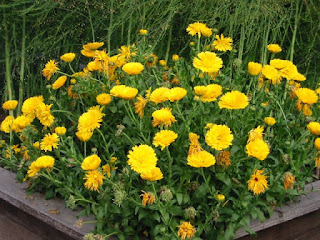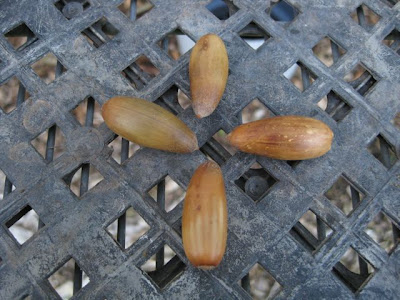Just as dependable as the January appearance of the fragrant, yet short-lived flowers on the winter daphne, some of the same New Year's resolutions keep blooming and fading, year after year. Learning a foreign language, cleaning the garage and mastering a musical instrument are a few of my yearly (unfulfilled) favorites. But, on a more realistic scale, there are some gardening resolutions that all of us can fulfill with a little effort in 2013:
* Stop the Bug Battle Before it Starts. Stressed plants attract pests and diseases. Keeping flowers, vegetables, trees and shrubs healthy can ward off all sorts of problems, saving you time and money. Applying the correct amount of water and fertilizer, as well as planting in the right place, helps plants get off to a strong start. The Sunset Western Garden Book is an excellent reference for the "right plant in the right place."
* Pinpoint That Pest. Before you spray, know what bug you are spraying. Identify the pest, using a good reference book such as, "Pests of the Garden and Small Farm" or "Pests of Landscape Trees and Shrubs" from the Ag and Natural Resources division of the University of California. Both those books take an Integrated Pest Management approach, which can help lead you towards using less toxic pesticides in your battles against the bad bugs. A qualified nurseryperson or your local Cooperative Extension office can also help you identify the bad bugs. A list of the most common bad guys can be found here.
* Consider pesticide alternatives before spraying potentially dangerous chemicals. Among your safest choices: a blast of water from your garden hose can dislodge aphids from the backs of leaves. Insecticidal soap can control a host of bad bugs (such as aphids, whiteflies and spider mites) without harming the good ones (ladybugs, praying mantis and honey bees). Other lower-toxicity choices include iron phosphate for snail control; Bt (mosquito larvae, caterpillars, cabbage loopers) or Spinosad for cabbage looper, caterpillar, leafroller, codling moth, thrip control.
* Choose the least toxic product. If all else fails and you decide to use a chemical insecticide, fungicide or herbicide, Look for the words CAUTION, WARNING or DANGER in bold letters on the label. A product with CAUTION on the label contains slightly toxic materials; WARNING indicates moderate toxicity; DANGER signifies a highly toxic substance.
* Read all chemical label instructions carefully. Don't apply more of a chemical than what is called for on the label. Not only is it wasteful, but it's more dangerous for the person applying it.
• If the label doesn't list the pest, it probably won't kill it. Many times, gardeners will spray just about any pesticide on a plant to control a suspected bad bug. The information on the label of a chemical pesticide will tell you which pests the product controls.
* Stop the Bug Battle Before it Starts. Stressed plants attract pests and diseases. Keeping flowers, vegetables, trees and shrubs healthy can ward off all sorts of problems, saving you time and money. Applying the correct amount of water and fertilizer, as well as planting in the right place, helps plants get off to a strong start. The Sunset Western Garden Book is an excellent reference for the "right plant in the right place."
* Pinpoint That Pest. Before you spray, know what bug you are spraying. Identify the pest, using a good reference book such as, "Pests of the Garden and Small Farm" or "Pests of Landscape Trees and Shrubs" from the Ag and Natural Resources division of the University of California. Both those books take an Integrated Pest Management approach, which can help lead you towards using less toxic pesticides in your battles against the bad bugs. A qualified nurseryperson or your local Cooperative Extension office can also help you identify the bad bugs. A list of the most common bad guys can be found here.
* Consider pesticide alternatives before spraying potentially dangerous chemicals. Among your safest choices: a blast of water from your garden hose can dislodge aphids from the backs of leaves. Insecticidal soap can control a host of bad bugs (such as aphids, whiteflies and spider mites) without harming the good ones (ladybugs, praying mantis and honey bees). Other lower-toxicity choices include iron phosphate for snail control; Bt (mosquito larvae, caterpillars, cabbage loopers) or Spinosad for cabbage looper, caterpillar, leafroller, codling moth, thrip control.
* Choose the least toxic product. If all else fails and you decide to use a chemical insecticide, fungicide or herbicide, Look for the words CAUTION, WARNING or DANGER in bold letters on the label. A product with CAUTION on the label contains slightly toxic materials; WARNING indicates moderate toxicity; DANGER signifies a highly toxic substance.
* Read all chemical label instructions carefully. Don't apply more of a chemical than what is called for on the label. Not only is it wasteful, but it's more dangerous for the person applying it.
• If the label doesn't list the pest, it probably won't kill it. Many times, gardeners will spray just about any pesticide on a plant to control a suspected bad bug. The information on the label of a chemical pesticide will tell you which pests the product controls.
• When using chemicals, employ a separate sprayer, either hose-end or tank sprayer, for different tasks. Use one sprayer for herbicides (such as Roundup or any weed killers); use another sprayer for insecticides and fungicides. It's not uncommon for gardeners to lose prized plants because they didn't rinse out a herbicide thoroughly from a sprayer before using the same unit for insect or leaf disease control. Rinse out the sprayer and nozzle after each use.
• Use less water. Turn off your lawn's automatic sprinklers during the winter. Install drip irrigation or soaker hoses around outdoor trees and shrubs. In the summer, reduce your watering time so that sprinkler water won't puddle up and run off the grass. Tips for using less water? Check this out.
• Water Wisely. It's been said that 90% of all plant problems can be traced back to a watering problem. Know how much water you are putting on your lawn and plants. Watering twice a week should be sufficient for most plants in the ground, including lawns, from April through October. Containerized plants on a hot patio may need to watered daily during the summer. Make sure the soil isn't too muddy or too dry the day AFTER watering. A moisture meter will let you know how wet the soil is at the root level of your plants.
• Plan before you plant. Consider only those vegetables that you know your family will eat. Plant flowers that attract beneficial insects (more info here). Grow several different annuals that will give you a succession of color through the year. Use water-stingy perennials and drought tolerant plantsfor a low-maintenance garden.
• Ponder Some More Before You Plant. Is that tree or shrub you'll be thinking about buying for your yard a good choice? Is it meant for our area? Is there enough sun (or shade) as well as room for it as it matures? One common mistake people make when planting: transplanting an itty bitty tree from a small container to an area that is too close to the house or fence. In just a few years, that little specimen may be twenty feet tall and wide. Again, the Sunset Western Garden Book should be your go-to reference.
• Patience, patience. Don't assume that an entire plant was killed by a wintry frost or freeze. Many plants can lose their leaves and top stems during cold weather, yet rebound from the base of the plant in spring, putting out new growth. Again, leave the damaged portions on the plant until late winter or early spring. Remember the "bend or break" rule: if a branch snaps in two under gentle pressure, it is probably dead. If it bends, it still has life. More info here.
• Yank out your 2012 summer vegetable plants. If you live in an area where temperatures fall below 32 degrees, those peppers, squash and tomato plants are definitely goners, and won't be coming back to life. Instead, start catalog shopping for seeds for your summer vegetable garden in the weeks ahead. Here's a link to a vegetable planting calendar for Northern California.
• Remove any sucker growth on citrus trees. Sometimes, a heavy freeze can damage your orange, lemon or lime trees so much that the tree sends out new shoots from the rootstock. These branches will produce heavy thorns and inedible fruit, if any. More info here on citrus suckers.
• Patience, patience. Don't assume that an entire plant was killed by a wintry frost or freeze. Many plants can lose their leaves and top stems during cold weather, yet rebound from the base of the plant in spring, putting out new growth. Again, leave the damaged portions on the plant until late winter or early spring. Remember the "bend or break" rule: if a branch snaps in two under gentle pressure, it is probably dead. If it bends, it still has life. More info here.
• Yank out your 2012 summer vegetable plants. If you live in an area where temperatures fall below 32 degrees, those peppers, squash and tomato plants are definitely goners, and won't be coming back to life. Instead, start catalog shopping for seeds for your summer vegetable garden in the weeks ahead. Here's a link to a vegetable planting calendar for Northern California.
• Remove any sucker growth on citrus trees. Sometimes, a heavy freeze can damage your orange, lemon or lime trees so much that the tree sends out new shoots from the rootstock. These branches will produce heavy thorns and inedible fruit, if any. More info here on citrus suckers.
• Remove any underperforming fruit trees now. Peach, apricot and nectarine trees that produce more sick leaves than fruit should be replaced with better deciduous fruit tree varieties, which are more compatible with our area. Nurseries are now getting in their shipments of bare root fruit trees; shop now for the best selection. Bare Root fruit tree buying hints here.
• Take out any ho-hum rose bushes that produce few warm weather blooms. Garden centers will have a good supply of new, bare root roses in January. The best roses for California? Check this list.
• Take out any ho-hum rose bushes that produce few warm weather blooms. Garden centers will have a good supply of new, bare root roses in January. The best roses for California? Check this list.
• Start a compost pile, compost bin or worm composting bin. Yard and kitchen waste that is put to use in the backyard garden benefits not only your soil but cuts down on the need for expanding (and dwindling numbers of) landfills. A good online source for composting basics can be found at mastercomposter.com.
• ENJOY gardening in the new year. Don't let the work (or failure of success) sour the experience. Remember what awaits you this year for your efforts: the late winter beauty of the first blooming tulip, quince or flowering cherry tree, the taste of a homegrown tomato and the bounty of a seemingly endless supply of summertime zucchini.
• Don't plant so much zucchini.
• ENJOY gardening in the new year. Don't let the work (or failure of success) sour the experience. Remember what awaits you this year for your efforts: the late winter beauty of the first blooming tulip, quince or flowering cherry tree, the taste of a homegrown tomato and the bounty of a seemingly endless supply of summertime zucchini.
• Don't plant so much zucchini.








































